- (2015) Volume 16, Issue 2
Megan Winner1, Amrita Sethi2, John M Poneros2, Stavros N Stavropoulos4, Peter Francisco4, Charles J Lightdale2, John D Allendorf5, Peter D Stevens2,3 and Tamas A Gonda2*
Departments of 1Surgery, 2Division of Digestive and Liver Disease, Department of Medicine, 3Deceased, Columbia University, New York, Department of 4Medicine, 5Surgery, Winthrop University Hospital, Mineola, NY, USA
Received November 20th, 2014 – Accepted January 26th, 2014
Context Molecular analysis of pancreatic cyst fluid obtained by EUS-FNA may increase diagnostic accuracy. We evaluated the utility of cystfluid molecular analysis, including mutational analysis of K-ras, loss of heterozygosity (LOH) at tumor suppressor loci, and DNA content in the diagnoses and surveillance of pancreatic cysts. Methods We retrospectively reviewed the Columbia University Pancreas Center database for all patients who underwent EUS/FNA for the evaluation of pancreatic cystic lesions followed by surgical resection or surveillance between 2006 - 2011. We compared accuracy of molecular analysis for mucinous etiology and malignant behavior to cyst-fluid CEA and cytology and surgical pathology in resected tumors. We recorded changes in molecular features over serial encounters in tumors under surveillance. Differences across groups were compared using Student’s t or the Mann-Whitney U test for continuous variables and the Fisher’s exact test for binary variables. Results Among 40 resected cysts with intermediate-risk features, molecular characteristics increased the diagnostic yield of EUS-FNA (n=11) but identified mucinous cysts less accurately than cyst fluid CEA (P=0.21 vs. 0.03). The combination of a K-ras mutation and ≥2 loss of heterozygosity was highly specific (96%) but insensitive for malignant behavior (50%). Initial data on surveillance (n=16) suggests that molecular changes occur frequently, and do not correlate with changes in cyst size, morphology, or CEA. Conclusions In intermediate-risk pancreatic cysts, the presence of a K-ras mutation or loss of heterozygosity suggests mucinous etiology. K-ras mutation plus ≥2 loss of heterozygosity is strongly associated with malignancy, but sensitivity is low; while the presence of these mutations may be helpful, negative findings are uninformative. Molecular changes are observed in the course of cyst surveillance, whichmay be significant in long-term follow-up
DNA Mutational Analysis; Pancreatic Neoplasms; Pancreatic Cyst
Pancreatic cystic tumors comprise a diverse group of pathologies with variable malignant potential. The need to accurately characterize these tumors is driven by the potential to prevent pancreatic cancer balanced with the risk of performing potentially unnecessary pancreatic surgery. Current treatment guidelines primarily depend on imaging features to stratify tumors by malignant potential [1-6]. For example, the presence of an associated mass or mural nodule, cystic dilation of the main pancreatic duct, and cyst wall thickening have all been associated with a higher risk of malignancy and are contributing indications for surgical resection [1-7]. At the other extreme, honeycomb appearance with central calcification or a pancreatitis-associated cyst favor benign diagnoses of serous cystadenoma and pseudocyst, which warrant no further testing. Unfortunately, the majority of cystic lesions are not easy to categorize. Size cut-off alone has been shown in several studies to be a useful but inconclusive marker of malignancy [7-10]. Fluid aspiration for cytologic and biochemical analysis has emerged as a valuable diagnostic adjunct.
EUS-guided cyst fluid aspiration has become a routine procedure and is recommended for most pancreatic cysts when imaging is inconclusive [11]. While most definitive, cytologic analysis is often low yield. Testing cyst fluid for cancer markers such as carcinoembryonic antigen (CEA) can help characterize cyst etiology. In the largest series to date based on surgical pathology, Brugge and colleagues found an elevated cyst-fluid CEA (≥192 ng/mL) to be a moderately sensitive (75%) and specific (83.6%) marker for mucinous cystic tumors [12]. However, as appropriate management is closely tied to the identification of mucinous (i.e.,premalignant) tumors, higher greater diagnostic accuracy is desirable. Furthermore, the correlation between CEA levels and malignancy or risk of progression has not been established [12-15].
Recent studies suggest that testing cyst fluid for mutations common to pancreatobiliary neoplasms may increase diagnostic accuracy, both in differentiating mucinous from non-mucinous cysts and detecting malignancy [5, 6, 16-20]. Our goal was to examine the diagnostic utility of interrogating cyst-fluid aspirates for DNA content and molecular changes at 17 genomic sites, including sequencing for an activating K-ras point mutation and loss of heterozygosity (LOH) analysis of microsatellites located at 1p, 3p, 5q, 9p, 10q, 17p, 17q, 21q, and 22q, in characterizing cystic tumors that had been surgically resected.
Patients and Data Collection
We queried our single-center clinical database for patients with a cystic tumor of the pancreas diagnosed between 2006 and 2011. Pancreatic cystic lesions that were not associated with a mass lesion or occurred in the setting of a known malignancy were included. We retrospectively reviewed prospectively collected data for all patients who underwent molecular analysis of pancreatic cyst fluid prior to surgical resection. We excluded patients in whom a mass or solid component (i.e., a mural nodule) was the target of FNA sampling for molecular analysis. Malignancy was defined when histologic confirmation of invasive adenocarcinoma was obtained at the time of surgical resection. The study was approved by the Columbia University Institutional Review Board.
Endosonography and Biochemical Fluid Analysis
EUS-FNA was performed with a curvilinear echoendoscope (GIF UC140P, Olympus, Center Valley, PA, USA) using standard 25-, 22-, or 19-gauge needles. Serial exams were performed by the same gastroenterologist. Cytologic evaluation of cyst aspirates employed standard criteria for malignancy and cyst fluid CEA was measured according to routine laboratory protocols.
Molecular Analysis
Cyst fluid obtained by EUS-FNA was tested (Redpath Integrated Pathology, Pittsburgh, PA, USA) for individual mutations, as previously described [9-11]. Molecular criteria suggesting mucinous etiology included: (1) the presence of a K-ras point mutation; (2) the presence of two or more LOH; or (3) an elevated quantity of DNA in the specimen. Each specimen was also assigned to a Composite Diagnostic Category of "Favor Benign" and "Favor Aggressive" based on both the clinical impression, fluid cytology, CEA and amylase results as well as the molecular cyst fluid analysis and adjunct tests The Aggressive designation was assigned to any cyst that met criteria for mucinous lesion and had a high amplitude (>75%) K-ras mutation followed by allelic loss.
Continuous variables were described by mean and standard deviation (normal distribution) or by median plus interquartile-range (non-normal). Differences across groups were compared using Student’s t or the Mann-Whitney U test for continuous variables and the Fisher’s exact test for binary variables. Correlation between continuous variables was assessed using linear regression models. All tests were two-tailed; in order to minimize overall type I error, only select associations were tested for statistical significance. Statistical analysis was performed using SAS 9.2 Software (SAS Institute, Inc., Cary, NC, USA).
Validation of Molecular Analysis against Surgical Pathology
Six-hundreds and five patients underwent evaluation for pancreatic cysts between 2006 and 2012, and 200 patients underwent surgical resection. Among these patients 40 had pre-operative EUS/FNA with cyst fluid molecular analysis. Patient characteristics and cyst features of included cases are shown in Table 1. Surgical pathology revealed three serous cystadenomas, one vascular malformation, and three neuroendocrine tumors with benign features, all considered benign, non-mucinous tumors. Seven mucinous cystadenomas (MCN) and 16 intraductal papillary mucinous neoplasms (IPMN) with either low-grade (n=7) or borderline dysplasia (n=9) were considered benign, mucinous tumors. Malignant mucinous cysts included two ductal adenocarcinomas and six IPMN with carcinoma in situ (n=3) or invasive carcinoma (n=3). Malignant nonmucinous cysts included one cholangiocarcinoma and one neuroendocrine tumor with malignant features. The final pathologic designation was based on the surgical pathology report. The cystic lesions aspirated were the only site of biopsy in all of these patients, therefore they are likely not associated cystic degeneration of a primary tumor.
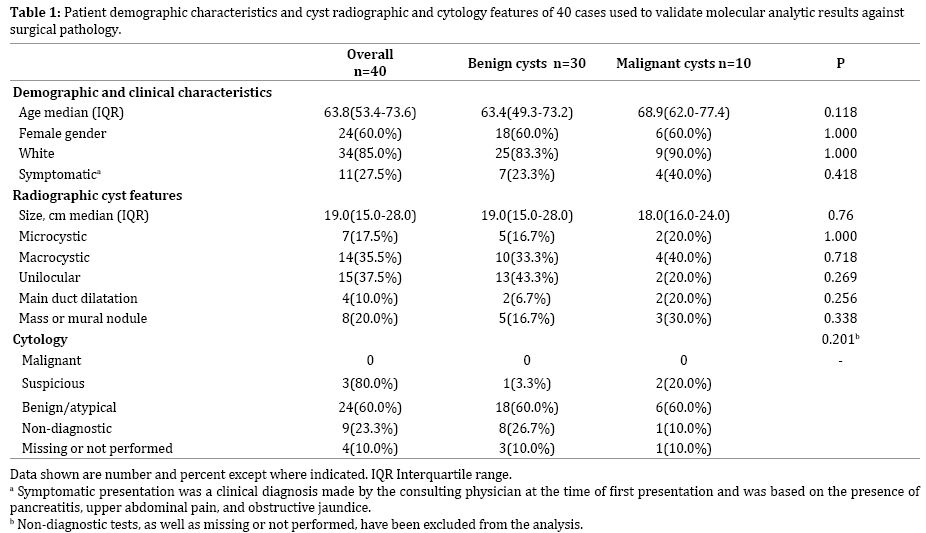
Table 2 shows the biochemical and molecular features of 40 cysts and the performance of different criteria in diagnosing mucinous etiology. Cyst fluid was adequate for CEA analysis in 29 cases (72.5% overall) and in 23/31 (76.7%) mucinous cysts. The sensitivity and specificity in our cohort for determination of mucinous etiology based on CEA ≥192ng/mL was 78.3% and 80.0%. All samples were sufficient for K-rasgenotyping but two could not be assessed for loss of heterozygosity (LOH). The presence of a K-ras mutation alone was insensitive (48.4%) but highly specific (88.9%) for mucinous etiology. When several molecular indicators were combined into a criterion indicative of mucinous etiology (see methods), the combination of features resulted in an increase sensitivity (79.3%) but a decreased specificity (44.4%) for mucinous pathology.
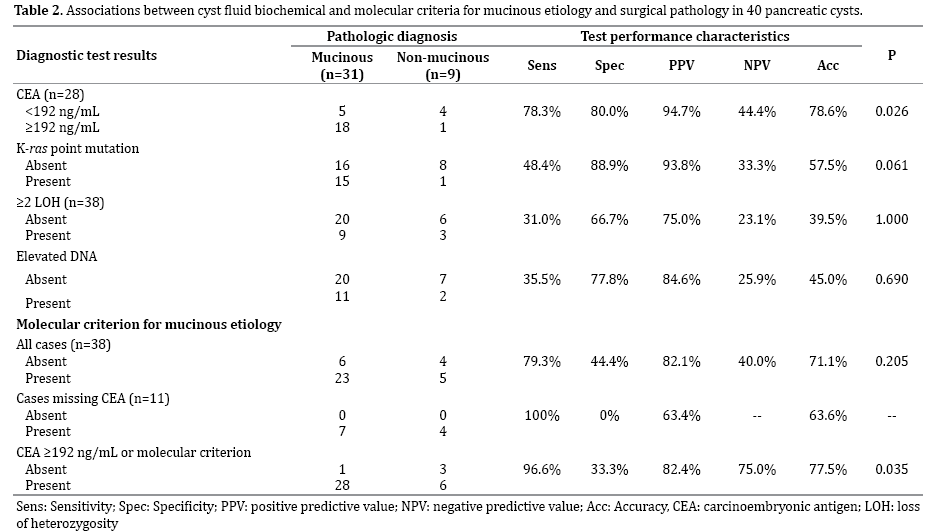
Among nine cysts with a CEA level below 192ng/mL, eight had complete molecular results (including LOH); the molecular criterion for mucinous etiology correctly identified 3/4 mucinous and 3/4 non-mucinous cysts (accuracy=75%). Among 11 cysts with fluid inadequate for CEA analysis, the molecular criterion correctly identified 7/7 mucinous cysts at the expense of four false positive results. As a result, the addition of molecular to CEA analysis (in which molecular features suggestive of mucinous etiology superseded CEA results) improved the sensitivity for detection of mucinous tumors and importantly increased the diagnostic yield of EUS-FNA (i.e, the number of patients with interpretable results).
Table 3 shows the biochemical and molecular features of 36 cysts and the performance of various criteria in diagnosing malignant behavior. A K-ras point mutation was equally likely to be detected in malignant versus mucinous cysts (44.4%), but malignant cysts were more likely to demonstrate an elevated quantity of DNA (66.7% vs. 22.2%, p=0.036) and any loss of heterozygosity (87.5% vs. 38.5%, p=0.039, see supplementary table 1). Detection of both a K-ras point mutation and ≥2LOH, while poorly sensitive for malignant tumors, was highly specific (96.2%). There was no significant difference in the accuracy of CEA versus K-ras or LOH in the diagnosis of mucinous cysts or malignancy. A combination of CEA and molecular methods was significantly more sensitive than either CEA or molecular methods combined in the diagnosis of mucinous lesions.
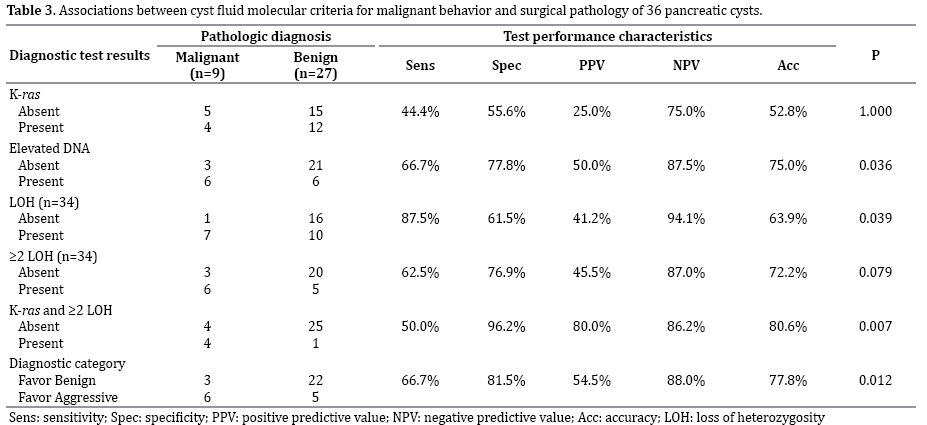
Each case was also reviewed based on all available clinical information, fluid characteristics and fluid DNA mutational analysis. A Composite Diagnostic Criteria was created and the cases were classified as "Favor Benign "or "Favor Aggressive". Examples of how this synthesized review may help in the diagnosis are provided in Table 4. Eleven cases were categorized as "Favor Aggressive "behavior in contrast to 5 cases by molecular criteria alone using the presence of K-ras mutation and >2 LOHs. The sensitivity in this category was 66.7% and the specificity of the Composite Diagnostic Category was 81.5%.
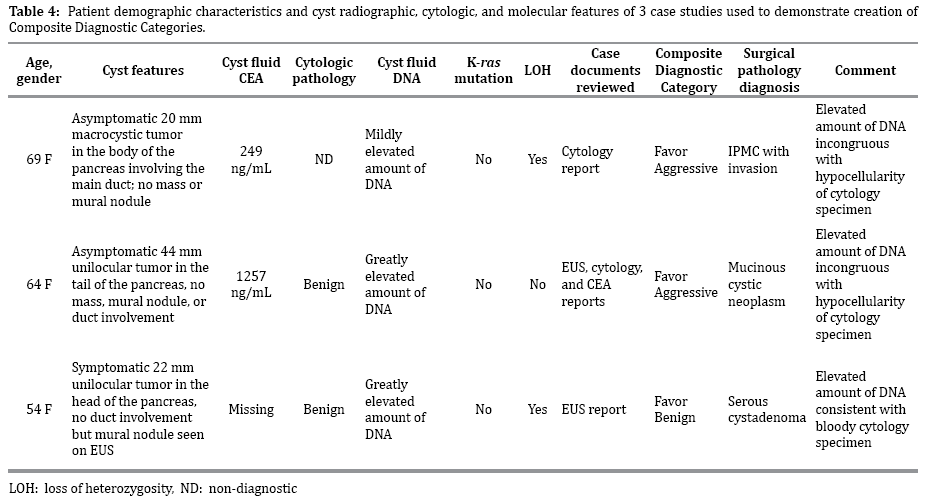
Surveillance of Pancreatic Cystic Neoplasms
To evaluate the utility of molecular testing in cyst surveillance, we identified 16 patients who had serial EUS-FNA molecular analyses of a pancreatic cyst (37 encounters). Serial examinations were performed a median of 10.6 months apart, with a range of 6.0 to 41.7 months. The median patient age at first encounter was 76.6 years (range 33.7- 85.0 years) and 44% were female. Baseline median cyst size was 17.5 mm (IQR 12.5-30.3 mm) and baseline median CEA was 302 ng/mL (IQR 140-578 ng/mL, n=9). Initial cytology was interpreted as benign (n=3), atypical (n=7), or non-diagnostic (n=6). All patients carried clinical diagnoses of low-grade mucinous tumors based on presentation and interpretation of radiologic, biochemical, and cytologic testing.
Change in Cyst Size and CEA
Between serial EUS encounters, the absolute change in cyst size ranged from -11 mm to +6 mm. Larger cysts tended to be measured smaller at follow-up (slope -0.29, P=0.008, r2=0.4). Cyst fluid was adequate for CEA analysis in 27/37 (73.0%) endoscopic encounters, but change in cyst fluid CEA over time could be measured in only nine instances. The percent change in CEA ranged from -64% to +4,820%. In most cases (8/9) repeat CEA measurement did not change cyst classification based on initial measurements (mucinous vs. non-mucinous). In one instance measured CEA increased from 140 to 6,889 ng/mL over three endoscopic encounters. Table 5 represents the endoscopic, biochemical, and molecular evolution observed between first and last endoscopic encounters for 16 cysts in 16 individuals. Ten cysts demonstrated newly detected K-ras point mutations or LOH, or an increase in clonality of a previously identified mutation. Three cysts accumulated a pattern of multiple mutations (K-ras and ≥2 LOH) that was associated with malignancy in the cohort of surgically resected patients (Table 3). One patient with accumulation of mutations subsequently underwent total pancreatectomy, which revealed mixed-type IPMN with invasive disease (ID#11); the other two remain under surveillance. Cysts with changes in molecular features seemed equally likely to demonstrate size increase (n=4), decrease (n=4), or no change (n=2).
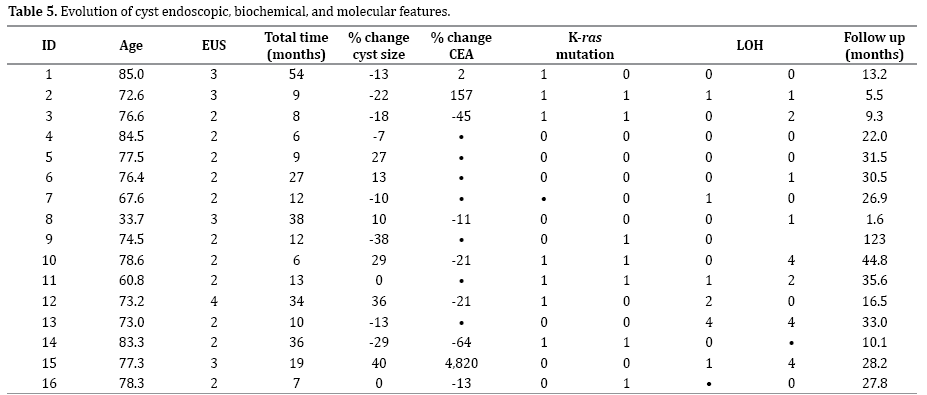
We observed molecular regression (i.e., previously detected mutations were no longer identified) in three cysts, and the molecular profile was stable in three more. Among these six, half demonstrated a change in size >20% between encounters.
We examined the diagnostic accuracy of molecular analysis of pancreatic cyst fluid (i.e., the presence of a K- ras mutation and LOH at tumor-suppressor loci) as compared with surgical pathology in 40 cystic neoplasms; this population tended to be low- or intermediate-risk according to standard criteria for surgical resection [1-3]. We found that individual molecular alterations were less accurate than cyst fluid CEA in predicting mucinous etiology (P=0.21 vs. P=0.03); however, the combination of K-ras mutation, DNA quantity and LOH was comparable in accuracy and therefore the addition of molecular criteria increased the diagnostic yield of EUS-FNA (i.e., the population with interpretable results, n=11). We were not surprised to find that malignant tumors tended to harbor a higher number of mutations; unfortunately, while the combination of a K-ras mutation and ≥2 LOH was statistically associated with malignancy(P<0.01), this criterion was insensitive (50%). The synthesis of molecular and clinical results into a Composite Diagnostic Category slightly increased sensitivity in detecting malignant behavior (67%). Finally, among 16 cysts under surveillance, many demonstrated changes in the molecular profile over time.
The accuracy of molecular features in predicting mucinous etiology and malignant behavior that we observed is similar to results reported by Khalid and colleagues [14]. In comparing this study with ours, it is important to contrast the examined populations. The aforementioned study included a higher proportion of malignant cysts (35% vs. 25% in the present study), and lesions that were symptomatic (49% vs. 29%), of large size (32% ≥3 cm vs. 23%), and with a solid component (37% vs. 20%). Finally, a cytologic diagnosis of malignancy was obtained in 32% of cases in the aforementioned study as compared to none of the cases described herein.
In the current study the detection of a K- ras mutation in cyst fluid aspirates, while specific for mucinous etiology, was insensitive. Rather, the value of molecular analysis was greatest as an adjunct to cyst-fluid CEA measurement, which in our study was the single most accurate criterion for establishing mucinous etiology. Indeed, detection of elevated CEA, regardless of the particular cut-off applied by various investigators [2], has endured as the most accurate test in distinguishing mucinous from non-mucinous cysts. Molecular analysis of cyst fluid in combination with CEA levels overcomes the main limitation of the latter assay, namely limited availability in cases of small aspirate volume or highly viscous fluid. We found that the addition of mutational analysis to CEA fluid measurement preserved the high sensitivity and specificity of the latter while increasing the diagnostic yield by almost 50%.
In examining the accuracy of molecular analysis in distinguishing malignant from benign cysts, we found that mutations were more numerous in malignant tumors and that the presence of both a K- ras mutation and ≥2 LOH was significantly associated with malignancy. This objective test was, however, insensitive for malignant behavior; synthesizing molecular analysis with adjunct clinical test results slightly increased the sensitivity for detecting malignant tumors.
We therefore propose that molecular analysis in a low- to intermediate-risk pancreatic cyst population may be of particular value in the following situations: (1) in cytologynegative cysts with elevated CEA(≥192 ng/mL) the presence of K- ras mutation followed by LOH is concerning and warrants significant consideration of malignancy; (2) in cytology-negative cysts with low CEA(<192 ng/mL) the presence of K- ras mutation, ≥2 LOH, or an elevated quantity of DNA should suggest mucinous etiology; and finally, (3) in otherwise benign-appearing cysts with low CEA(<192 ng/mL) the absence of either K- ras or LOH suggests low probability of mucinous etiology and a low probability of aggressive behavior.
When we examined 16 patients under surveillance we found that cyst characterization based on CEA level rarely changed; in addition, we discovered that molecular changes occurred frequently and did not seem to correlate with alterations in size, CEA level, or other features. While our data are not sufficient to draw conclusions at this time, we do envision a role for molecular analysis in the surveillance of low- and intermediate-risk pancreatic cysts. Because cyst fluid CEA measurements are most useful in diagnosis but not prognosis, we recommend against serial CEA measurements once diagnosis (i.e., mucinous vs. nonmucinous) has been established. An exception may be small cysts for which classification by multiple modalities is notoriously difficult.
Our study has several limitations, including the retrospective nature and the inability to include the vast majority of cysts sampled during the observational period due to the lack of final pathology. While our patient population was selected for surgical treatment and is therefore inherently biased, we emphasize that our patient population represents an overall lower-risk population than those presented in other similar series.
We have evaluated the utility of molecular cyst fluid analysis in the diagnosis of pancreatic cysts and have found objective molecular features to be useful in the differentiation of mucinous from non-mucinous cysts, especially in cases in which fluid CEA is missing. We have found that the accuracy of molecular features in distinguishing malignant from benign cysts remains suboptimal. Our experience with surveillance of pancreatic cysts is evolving and the role of fluid sampling remains limited. Initial experience indicates that serial resampling of cysts often reveals alterations in the molecular profile. Future prospective studies will answer the question whether these alterations hold clinical meaning and if serial sampling is a useful adjunct to radiographic surveillance.
Authors declare to have no conflict of interest.